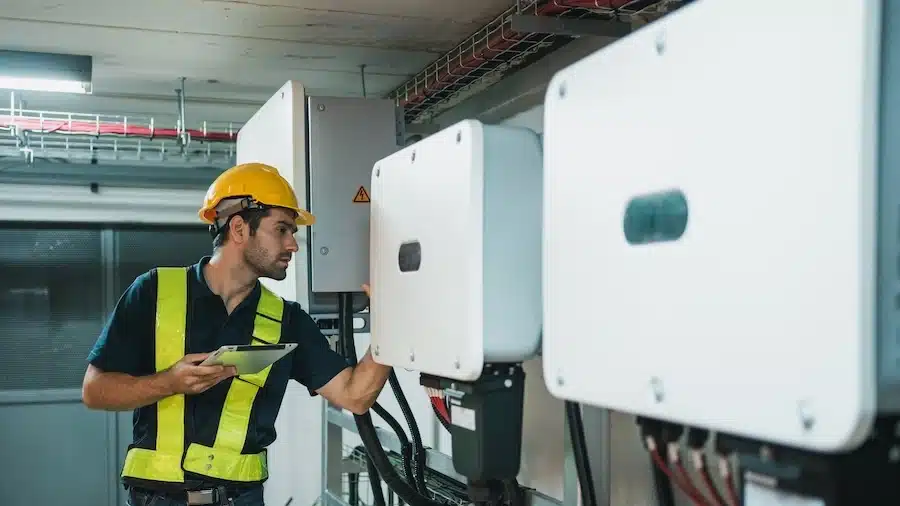‘Lab-grown’ meat is a bleeding-edge technology which could make plunderous, unethical meat consumption a thing of the past. We answer some of your biggest questions about this burgeoning industry, including how cultivated meat is made and what it’s like to eat.
Would you eat a burger that was grown in a lab? How about a pork chop?
These may be fun, dinnertime hypotheticals for now. But thanks to the rapidly-advancing field of cellular agriculture – or ‘cultivated meat’ – they may soon become as commonplace as choosing between two brands of rice.
Cellular agriculture promises to upend the $1.4 trillion global meat market, not to mention millennia of cultural traditions and social norms. But how far are we away from seeing the first lab-grown meat on our supermarket shelves?
And how is lab-grown meat even possible, anyway?
Higher Steaks
For a fun overview on all things lab-grown meat, check out episode 32 of GrantTree’s innovation podcast, What Comes Next?.
My co-hosts and I spoke to Benjamina Bollag, founder and CEO of cell-based meat company Higher Steaks, which is developing a line of pork.
Bollag explained how lab-grown meat is made, what the investment landscape looks like, and how far the first products are from market.

How do you make lab-grown meat?
Let’s start with the juicy, technical stuff: how does cell-based meat go from test tube to dinner table?
Well, there is no single method yet. But a general outline has emerged, inside of which much tinkering and streamlining is still taking place.
First, a cellular agriculture company extracts a tissue sample from a living animal via a biopsy.
The company collects the cells from the tissue and either stores them for later nurturing or, in the case of companies like Higher Steaks, reprogrammes them into ‘induced pluripotent stem cells’, or iPS cells.
iPS cells are created by reverse-engineering ‘primary cells’, like fat or blood cells, into stem cells.
The reprogramming works by introducing four genes responsible for creating pluripotent characteristics into a primary cell’s nucleus. These genes overwhelm the cells specialised functions, causing it to revert to pluripotent form after several rounds of cell division.
These iPS cells, whose discovery won the 2012 nobel prize for physiology or medicine, can then be turned – or ‘induced’ – into any cell found in the desired cut of meat. This flexibility – akin to retraining a middle-aged executive in an entirely new profession – makes iPS cells a potent raw material for cellular agriculturists.
As Benjamina explains: “From a blood or skin patch, we can make muscle, fat, connective tissue, and anything that we want and need.”
Interestingly, Higher Steaks’s use of iPS cells partly explains why the company is choosing to develop pork rather than beef or lamb. Physiologically-speaking, humans have more in common with pigs than other farmed animals. As most iPS cell research has been conducted on human samples, Higher Steaks has more research to draw on.
Once induced, the newly-formed satellite (the precursors to skeletal muscle), endothelial (which make up blood vessels), and fat cells are then transferred to a bioreactor. This is a device which maintains and monitors a biologically-active environment.
The cells float there in soup-like, nutrient-rich media where, provided with the right conditions and sustenance, they proliferate; multiplying through cell division and eventually forming a spongy, proteinous mass.
This ‘mass’ is the nascent meat that will be shaped and flavoured into a cultivated meat product.
Adding structure
Testors and journalists alike have described the consistency of this initial product as ‘mushy’.
While hardly a flattering description, mushy meat is perfectly usable in things like mince, sausages, and burger patties. Understandably, many cell-based meat producers see these household staples as easier routes to market.
But producers are also aiming higher; towards making their own lines of chicken nuggets, steaks and pork chops that would be nye-on identical to their farmhouse ancestors. But making cell-based meat with the right structure and texture is a major technical hurdle.
The solution seems to be ‘edible scaffolds’. These are 3D, extracellular matrices (ECM) which hold tissues together in a firm and appetizing shape.
Edible scaffolding works in theory. In practice, its challenging to find a material which is not only structurally suitable, but also ticks the right boxes in terms of flavour, nutrition, and edibility.
Earlier this year a group of researchers successfully created an ECM out of soy protein. The ECM was infused with myogenic growth factors which proliferate muscle cells, lending the meat a more robust consistency.
According to the article the team published in Nature Food, volunteers which tasted the product said its “taste, aroma and texture were pleasant and typical of real meat”.
A fair bit better than ‘mushy’.
While promising, soy protein does alter the flavour of the final product. But researchers are confident this can be resolved with salt and other seasonings. Other ECM materials are also being explored.
Technical challenges
Structure isn’t the only thing keeping cell-based meat products off our shelves.
Another major issue is the industry’s reliance on foetal bovine serum (FBS); a liquid extracted from foetuses exhumed from slaughtered cows.
Dubbed a “miracle juice” by the CEO of Finless Foods, FBS is one of the key ingredients in nutritional media, and contains many of the growth factors needed to proliferate cells.
FBS is vital to cell-based agriculture, but its use poses a huge problem for an industry that is trying to permanently divorce meat from animal. Many producers are determined to find a suitable substitute before their first products come to market.
FBS is not only ethically ruinous, it’s also prohibitively expensive. The serum costs up to £700 a litre, and about 50 litres of it are needed to cultivate a single burger’s worth of beef. This is in part because FBS is presently extracted on very small scales, and is usually sold on to medical research labs.
Producers are currently testing a range of ethically-sound alternatives to FBS. One involves microbial fermentation, which is used in the production of vegetarian cheese.
According to Wired, Finless Foods is also investigating extracts from algae and various fungi. Meanwhile, vegan egg-maker JUST is assembling a database of plant extracts and cataloguing which ones encourage the most proliferation in the relevant cell types.
Each of these options involves targeting individual tissue types with its own specific extract. We are unlikely to find a catch-all extract with the universality and prolificness of FBS.
How does lab-grown meat taste?
Down to brass tax. How will cell-based meat actually taste?
This question is harder to answer than you might think.
Flavour is complicated. How meat tastes depends on more than its constituent tissues. As any farmer will tell you, an animal’s diet, environment and quality of life all have an effect.
Bollag explains that “exercise can be simulated through in-vitro muscle stimulation”. But what about the impact of pasture soil and different kinds of feed?
Fundementally, it depends on how these factors affect the physiology of meat – something Higher Steaks and others are investigating. If a particular strain of grass alters a steak’s marbling – a purely structural change – then cell-based agriculturists could recreate this without much difficulty.
Subtler differences, for example in mineral content, are harder to emulate. Manufacturers will likely solve this by adding flavouring, rather than by tweaking their cultivation process. Major flavour houses have already been working this problem for plant-based meat manufacturers like Impossible Foods and Beyond Meat.
But Benjamina argues that, even without flavourings, differences in taste will be relatively minor: “in theory, if you have all the right cells, it’s going to taste exactly the same. Because it is the same down to a molecular level.”
This highlights an advantage that cell-based meat has over plant-based alternatives. Cultivated meat is still meat. The difference in taste and texture between a synthesised beef patty and the ‘real’ thing is far smaller than one made from, say, genetically modified soy.
For cell-based meat manufacturers, taste presents far less of a challenge than making meat products which resemble naturally-reared incumbents, and are grown cost-effectively in a media free from animal serum.
When can we eat it?
As with any cutting-edge industry, it’s unclear.
In October last year, JUST claimed its $50-a-piece chicken nugget was ready for the market. 11 months later, it is still waiting on regulatory approval in the United States.
Producers must overcome a range of technical challenges before they can produce commercially-viable, ethically-sound products. Then there’s the matter of rubber-stamping.
While an exact time to market remains uncertain, what is more obvious is the opportunity that exists for producers willing to stick it out.
According to Statista, almost £6 billion worth of fresh meat products are sold in the UK every year. Globally, this market is worth more than £1 trillion, and with surveys showing that upwards of 40% people would try lab-grown meat, there is a potentially vast, worldwide addressable market.
There is also opportunity outside the human market. Pet food company Because Animals has developed cat treats using cultured mouse meat.
Many producers think the pet food market might be a way into normalizing cell-based meat.
But why should we eat it lab-grown meat?
Market opportunity is one thing. But why should we as consumers eat cell-based meat?
The sad truth is that traditional animal farming has a lot of adverse side effects: for our health, for the environment, and for animal wellbeing.
Human health
Red meat contains saturated fat. Eating a lot of it can raise your cholesterol level, increasing your chances of heart disease. Thanks to the control manufacturers would have over their product, cell-based alternatives could have their saturated fat content reduced or completely removed.
But putting the relative drawbacks of different foods aside for a moment, there is another way that eating meat can have a significant impact on human health. It is a result of the systematic use of antibiotics by industrial meat farms.
The profligate use of drugs – 26% of antibiotics in the UK are used on food-producing animals – escalates the overall supply of antibiotics in our ecosystem. This drives antibiotic resistance and increases the prevalence of superbugs.
According to the World Health Organisation, drug-resistant diseases could be responsible for up to 10 million deaths a year by 2050.
Animal wellbeing
Eating animals requires killing animals. Some consider this a moral issue. But with 88% of Brittons eating meat as some part of their diet, it seems that most do not.
A more widely-accepted controversy, however, is the treatment of livestock. Many of the cows, chickens and pigs which go on to furnish our dinner plates are kept in stressful, unsavory conditions.
30% of dairy cows bred for dairy suffer from a bacterial infection of the udder; 90% of chicken production takes place in “intensive, windowless sheds” housing up to 50,000 birds; less than 3% of UK pigs spend their entire lives outdoors.
That an animal should die to feed a human may be ethically dismissed as part of a natural food chain. That an animal should suffer to do so, however, is far harder to rationalize by natural law.
The environment
Finally, animal farming causes massive damage to our environment.
Vast quantities of water and food are needed to feed livestock. This translates to a massive energy burden. 31.5 kWh of energy is required to produce a single pound of beef, enough to power a fridge-freezer for 4 days or an LED TV for almost 2 weeks.
Animals are also terribly inefficient. Pigs convert just 8.6% of the energy provided in feed into animal product. Cows; just 1.9%.
Livestock also produces a tremendous amount of greenhouse gas: 14% of all emissions from human activities are believed to come from animals and their care.
In all, reducing our meat and dairy consumption is considered the “single biggest way consumers can reduce their environmental impact on the planet”.
Cellular agriculture promises meat produced with far less energy, resulting in a major reduction in greenhouse gas emissions.
But some scientists still have their doubts.
Cultivated tissues don’t have an immune system, so they must be kept under sterile conditions to prevent disease and untimely decay. Maintaining a sterile environment uses a lot of energy, and produces a large amount of waste in the form of single-use plastics and tools.
A paper published by the University of Oxford also questioned whether the CO2 produced by cell-based meat labs was more damaging than the methane and nitrous oxide belched out by ruminants.
But with limited data to go on, and no large-scale cellular agriculture firms in operation, this paper is ultimately speculative.
Final thoughts
Cell-based meat offers carnivorous consumers a potentially healthier, ethically-sound, and more environmentally-friendly way to eat their burgers and chicken wings.
While the technology is a long way off commercial scale and regulatory approval, it’s easy to imagine this cheaper, healthier option arriving wholesale in the next decade.
Technical hurdles remain, most notably perfecting product structure and finding a viable substitute for FBS. But companies around the world are investing heavily in solving them.
Do you work in cutting-edge agriculture?
If you work in cutting-edge agriculture you could earn thousands of pounds in financial support from the UK government.
To discuss your eligibility for grants and R&D Tax Credits, speak to one of our government funding experts



